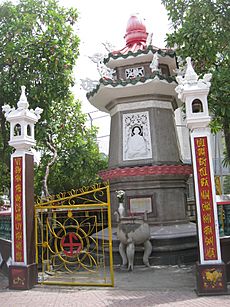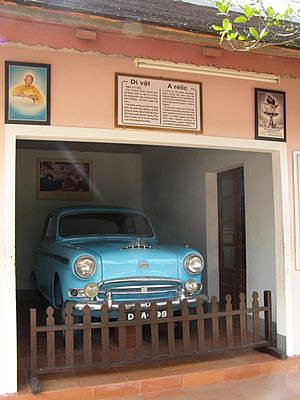Thích Quảng Đức facts for kids
Quick facts for kids Quảng Đức |
|
|---|---|
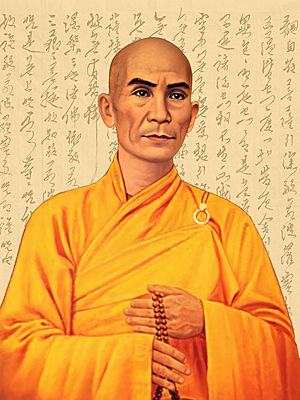 |
|
| Religion | Buddhism |
| Sect | Mahayana |
| Other names | Bồ Tát Thích Quảng Đức (Bodhisattva Thích Quảng Đức) |
| Personal | |
| Born | 1897 Hội Khánh, Annam, French Indochina |
| Died | 11 June 1963 (aged 65–66) Saigon, South Vietnam |
| Senior posting | |
| Based in | South Vietnam |
| Title | Buddhist monk |
| Period in office | 1917–1963 |
| Religious career | |
| Ordination | 1917 |
| Post |
|
Thích Quảng Đức was a Buddhist monk from Vietnam. He became famous around the world on June 11, 1963. On that day, he set himself on fire in a busy street in Saigon. He did this to protest how the government of Ngô Đình Diệm was treating Buddhists.
Diệm's government was supported by the United States. Diệm himself was a strong Roman Catholic. He treated Buddhists unfairly. Pictures of Quảng Đức's protest spread globally. They showed the world what was happening in Vietnam. John F. Kennedy, who was the US President, said one photo was the most emotional news picture ever.
Quảng Đức's act made other countries pressure Diệm. Diệm then said he would make changes to help Buddhists. But these changes never happened. This made the problems worse. Protests continued. Diệm's brother, Ngô Đình Nhu, led special forces to attack Buddhist temples. They even took Quảng Đức's heart. Other monks followed Quảng Đức's example. In the end, a coup (a sudden takeover of the government) removed Diệm from power. He was killed on November 2, 1963.
Contents
Early Life and Training
Thích Quảng Đức was born in 1897. His birth name was Lâm Văn Túc. He was born in a village called Hội Khánh in central Vietnam. He was one of seven children.
When he was seven, he started studying Buddhism. His uncle, Thích Hoằng Thâm, was his teacher. His uncle raised him like his own son. Lâm Văn Túc then changed his name to Nguyễn Văn Khiết. At age 15, he became a novice monk. By age 20, he was a full monk. He took the dharma name Thích Quảng Đức. The name Thích means "of the Shakya clan." This is the family of the Buddha.
After becoming a monk, he lived alone for three years. He stayed on a mountain near Ninh Hòa. He practiced Buddhism there. Later, he returned to open a temple called Thien Loc pagoda in that same mountain area.
Traveling and Building Temples
After his time alone, Quảng Đức began to travel. He went around central Vietnam. He taught Buddhist lessons to people. After two years, he went on a spiritual retreat. This was at the Sac Tu Thien An pagoda.
In 1932, he became an inspector for a Buddhist group in Ninh Hòa. Later, he became the inspector of monks in his home area. During this time, he helped build 14 temples in central Vietnam. In 1934, he moved to southern Vietnam. He continued to spread Buddhist teachings. He also spent two years in Cambodia. There, he studied a different kind of Buddhism called Theravada.
When he came back from Cambodia, he helped build 17 more temples in the south. In total, he helped build 31 new temples. The last one was the Quan The Am pagoda. This temple was on the edge of Saigon. The street where it stands was later renamed Quảng Đức Street in 1975. After building temples, Quảng Đức became a leader. He was the Chairman of Ceremonial Rites for Vietnamese Monks. He also became the head of the Phuoc Hoa pagoda. This was where the Association for Buddhist Studies of Vietnam (ABSV) started. He later left this role when the ABSV moved to a bigger temple.
Why Buddhists Protested
Most people in Vietnam were Buddhist. Some estimates say between 70% and 90% were Buddhist. But President Diệm was Catholic. His government treated Catholics better than Buddhists. For example, Catholics often got better jobs in the government and military. They also got more land and business help.
Diệm once told an officer to put Catholic officers in important jobs. He said they could be trusted. Many soldiers became Catholic to get promoted. Buddhist soldiers sometimes could not get promoted if they did not change their religion. Some Catholic priests even had their own armies. They forced people to convert. They also looted and destroyed Buddhist temples. The government did nothing to stop this.
Buddhism was seen as a "private" religion by the French. This meant Buddhists needed special permission for public events. Diệm kept this rule. Catholics did not have to do forced labor for the government. But everyone else did. Also, aid from the United States mostly went to Catholic villages. The Vatican flag was often flown at public events. Diệm even dedicated his country to the Virgin Mary.
Problems grew in May 1963. The government banned flying the Buddhist flag in Huế. This was just before Vesak, the Buddha's birthday. But days before, Catholics were allowed to fly the Vatican flag for a celebration. Many Buddhists protested the ban. They flew their flags anyway. They marched to a government radio station. Government forces shot into the crowd. Nine people died. Diệm blamed the Viet Cong for the deaths. He refused to take responsibility. This led to more protests. Buddhists demanded equal rights. Diệm still refused. So, protests happened more often.
The Day of the Protest
On June 10, 1963, reporters from the US heard something big would happen. It would be the next morning near the Cambodian embassy in Saigon. Many reporters didn't go. The Buddhist protests had been going on for over a month. But a few journalists showed up. These included David Halberstam from The New York Times and Malcolm Browne from the Associated Press (AP).
Quảng Đức arrived with a group of monks and nuns. About 350 people marched. They had banners in English and Vietnamese. The banners spoke out against Diệm's government. They demanded religious equality for Buddhists. Another monk wanted to be the one to protest. But Quảng Đức, being older, was chosen.
The protest happened at a busy street crossing. It was near the Presidential Palace. Quảng Đức left a letter. In it, he asked President Diệm to be kind to the people. He asked him to give religious equality. He also asked monks and Buddhists to unite and protect Buddhism.
After the Protest
After Quảng Đức's death, the US put more pressure on Diệm. They wanted him to talk to the Buddhists again. Diệm had planned a meeting to discuss the Buddhist crisis. He thought it was ending. But after Quảng Đức's protest, he canceled the meeting. He met with his ministers one by one. The US Ambassador warned Diệm's Secretary of State that things were very bad. He said Diệm needed to agree to the Buddhists' demands. The US Secretary of State even said the White House would stop supporting Diệm if he didn't act. An agreement with the Buddhists was signed on June 16.
Quảng Đức's funeral was set for June 15. Four thousand people gathered. But the ceremony was put off. On June 19, his body was taken to a cemetery outside the city. There, a new cremation and funeral happened. Only about 500 monks were allowed to attend. This was part of the agreement with the police.
The Intact Heart and Its Meaning
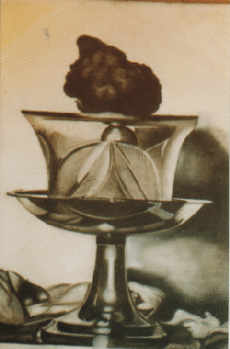
During the funeral, Quảng Đức's body was burned again. But his heart supposedly did not burn. It stayed whole. People believed it was a holy sign. It was put in a glass cup at the Xá Lợi Pagoda. This intact heart is seen as a symbol of compassion. Vietnamese Buddhists now honor Quảng Đức as a bodhisattva. This means a person who has reached enlightenment but delays nirvana to help others. So, he is often called Bồ Tát Thích Quảng Đức.
On August 21, Diệm's brother's special forces attacked Xá Lợi and other Buddhist temples. They wanted to take Quảng Đức's ashes. But two monks escaped with the urn. They jumped over a fence and found safety at the US mission next door. Diệm's men did manage to take Quảng Đức's charred heart.
The place where Quảng Đức protested was in front of the Cambodian embassy. Some wondered if this was planned. It might have been to show support for Cambodia. Vietnam and Cambodia had problems at the time. Cambodia's leader had accused Diệm of treating Buddhists badly.
Diệm's Response and Impact
Diệm spoke on the radio the day Quảng Đức died. He said he was very sad about the event. He asked for peace and loyalty to the country. He said talks with Buddhists would start again. He claimed talks had been going well. He also talked about his Catholic beliefs. He said extremists had twisted the facts. He told Buddhists they could trust him and the country's laws.
The army showed support for Diệm. This was to make it seem like there were no problems. Thirty high-ranking officers said they would follow all orders. But this was just a show. Many of these officers were secretly planning to overthrow Diệm. The generals who led the coup were not in Vietnam at the time.
How the World Reacted
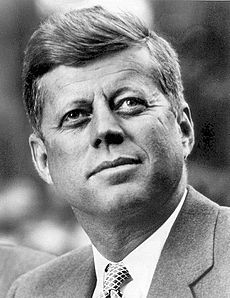
Malcolm Browne's photos quickly spread. They were on the front pages of newspapers everywhere. Quảng Đức's death became a turning point. It helped lead to the fall of Diệm's government.
President John F. Kennedy saw the news when he was on the phone. He reportedly said, "Jesus Christ!" He later said no news picture had ever caused so much emotion. US Senator Frank Church said such terrible scenes had not been seen since early Christians were killed in Roman arenas.
In Europe, the photos were sold as postcards. Communist China printed millions of copies. They sent them across Asia and Africa. They used them to show what they called US imperialism. One of Browne's photos is still on the car Quảng Đức used. This car is now a tourist attraction in Huế.
For Malcolm Browne and the Associated Press, the photos were a huge success. Another reporter, who forgot his camera, was criticized by his boss. Many people switched to AP news because of the photos.
Almost 30 years later, one of Browne's photos was used. It became the cover art for the band Rage Against the Machine's first album.
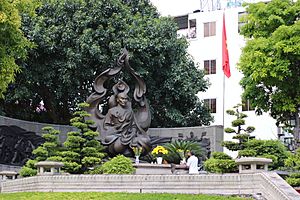
See also
 In Spanish: Thích Quảng Đức para niños
In Spanish: Thích Quảng Đức para niños


